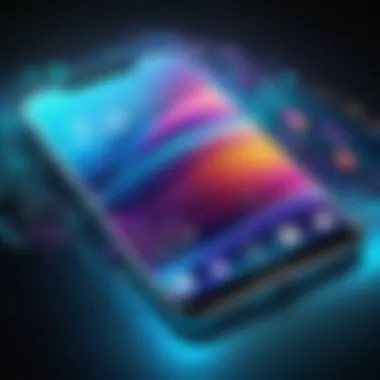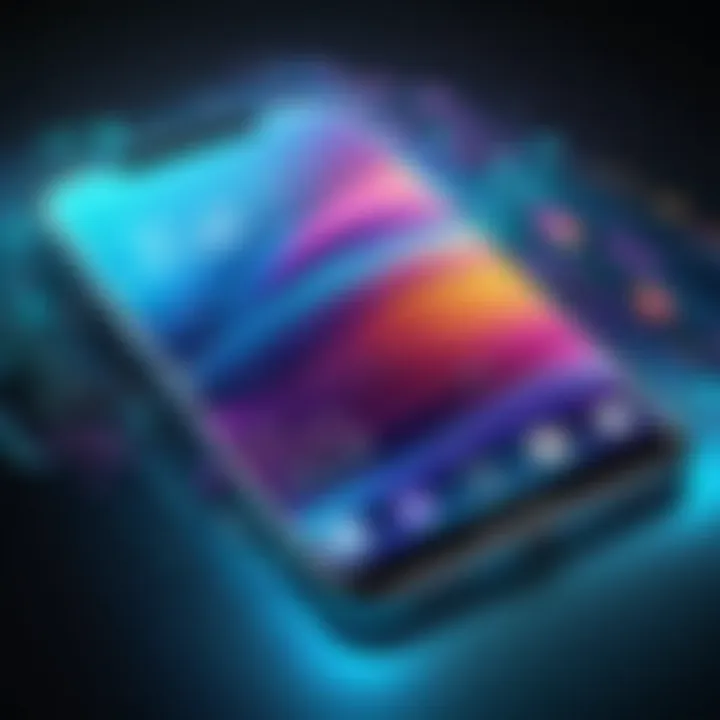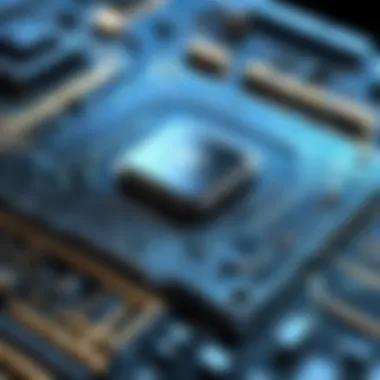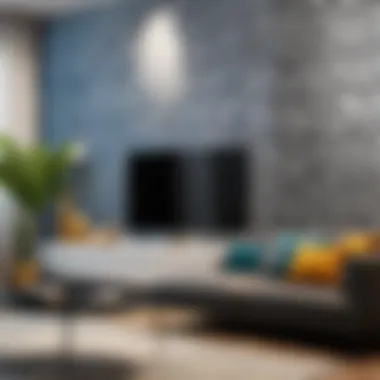Understanding the Impact of 4D Wallpaper Apps


Intro
In today’s fast-paced digital landscape, visuals hold tremendous power. It’s no wonder that wallpaper apps—those seemingly simple applications that adorn your mobile device's screen—have evolved significantly. Take a moment to imagine how something as mundane as a background can transport the viewer into a world of vivid imagery and animation. Enter 4D wallpaper apps, a next-gen phenomenon that bridges technology with creativity in entirely new ways.
These apps go beyond traditional static backgrounds, offering dynamic, engaging visuals that seem to leap off the screen. By employing advanced graphics and animation techniques, they serve not only as aesthetic enhancements but also as reflections of user identity and preference. The appeal of 4D wallpaper apps lies in their ability to transform a standard home screen into an immersive experience, creating a connection between the user and their device that feels personal and interactive.
As we dive deeper into this article, we’ll uncover the nuts and bolts of how these apps function, their cultural relevance, and the ways they have carved out a niche in the ever-evolving world of consumer technology. This exploration will arm you with insights that highlight not only what 4D wallpaper apps are but also why they matter.
Overview of the Technology
The technological foundation of 4D wallpaper apps is anchored in the intersection of software development and multimedia artistry. These apps utilize various techniques to create the illusion of depth and motion, drawing users into an ephemeral realm of creativity.
Key specifications
To better understand their functionality, let's take a closer look at some key specifications:
- Resolution: High definition graphics often ranging between 1080p to 4K.
- Frame Rate: Typically operates at 30 to 60 frames per second for smooth transitions.
- Compatibility: These apps are designed to work seamlessly with major operating systems like Android and iOS.
- Customization: Options for users to adjust animations, screen positioning, and even sync with music.
Unique Selling Points
Several aspects make 4D wallpaper apps stand out:
- Immersive Experience: Users can interact with live wallpapers, creating personal connections with their device.
- Regular Updates: Continuous fresh content provides users with new visuals and keeps their device feeling relevant.
- Community-Driven: Many apps allow users to share their designs, fostering a sense of community among enthusiasts who appreciate digital art.
"In an age where digital identity matters profoundly, a captivating wallpaper can significantly enhance one's personal tone and aesthetic resonance."
Design and Build Quality
The user interface design in 4D wallpaper apps plays a crucial role in delivering a satisfying user experience. The choice of materials and usability design elements greatly influence how users interact with these applications.
Material Used
Most apps are developed with high-quality visual components, often leveraging cutting-edge graphics engines like Unity or Unreal Engine. These choices ensure that the wallpapers not only look stunning but also respond fluidly to user input, be it tapping or scrolling.
Ergonomics and Usability
When it comes to ergonomics, the goal is to make the interface intuitive and navigable. Key factors include:
- Simplified Navigation: Users appreciate a straightforward layout for quick access to features.
- Customization Tools: Easy-to-use sliders and toggles let users fine-tune their experience without frustration.
- Battery Efficiency: Apps designed with power consumption in mind can prolong device battery life, a critical consideration for smartphone users.
This careful marriage of technology and user experience creates an ecosystem where 4D wallpaper applications can flourish. As we continue to explore their impact, it’s essential to recognize how these applications shape user engagement in modern digital culture.
Prelims to 4D Wallpapers
In the ever-evolving realm of digital technology, 4D wallpapers have emerged as a standout feature for users keen on personalizing their devices. They elevate the standard wallpaper experience by introducing motion and depth, allowing users to engage with their screens in novel ways. This section outlines the significance of understanding 4D wallpapers, showcasing their unique traits, benefits, and considerations that contribute to their growing popularity in mobile devices.
Defining 4D Wallpapers
At its core, a 4D wallpaper is an animated background for one's device that creates a sense of depth and movement, merging the typical flat image with dynamic elements. Unlike static wallpapers that merely serve as scenic backdrops, 4D wallpapers employ advanced graphics techniques to enrich the visual experience.
The term "4D" often confuses some, as it hints at a spatial quality; however, it primarily refers to the interactive and vibrant nature of these applications. Users can encounter wallpapers that respond to touch or device orientation, further bridging the gap between user and device. Imagine a serene ocean scene where waves ripple as you tilt your phone—this immersive experience is what sets 4D wallpapers apart.
Historical Context of Wallpaper Applications
The journey of wallpapers began with simple, static images. In the early days of smartphone technology, the focus was mainly on personal preference. Users selected images that resonated with their personalities or interests, often featuring landscapes, loved ones, or art. As mobile technology progressed, so did the capability to enhance these images. With the arrival of live wallpapers, users got the chance to engage with moving backgrounds. However, the real leap came with 4D wallpapers, which added layers of interaction and immersion, not just in design but also in functionality.
In 2010, one could say that the seeds of 4D wallpaper technology were sown as smartphones began integrating gyroscopic sensors and accelerometers more widely. This change enabled developers to innovate further, transforming visual aesthetics into interactive experiences. It was an enticing prospect for designers and users alike, as it redefined device personalization.
When looking at the historical context, we see that every evolution in wallpaper technology reflects larger trends in user engagement and visual sophistication. From paper wallpapers in our homes to dynamic backgrounds on our devices, the essence has always been aesthetics and personalization, evolving with our technological advancements.
In summary, 4D wallpapers hold significant importance. They push the boundaries of what users can do with their devices, offer a level of engagement previously unseen, and serve as a canvas for creativity. As technology continues to advance, understanding the foundation and context of these applications primes us for the future, setting the stage for improved user experiences and innovative designs.
The Technology Behind 4D Wallpaper Apps


The emergence of 4D wallpaper apps signifies a notable shift in how users interact with their devices. The technology powering these applications is crucial for facilitating an immersive and enchanting experience. By harnessing advanced graphics, rendering techniques, and the interplay of motion sensors, 4D wallpapers elevate mundane screens into dynamic canvases of visual storytelling. This transformation underscores the importance of understanding the various technological components at play, as they not only enhance aesthetic appeal but also influence user engagement and satisfaction.
Graphics and Rendering Techniques
When it comes to 4D wallpaper apps, graphics and rendering techniques form the backbone of their functionality. At its core, these techniques are what create the mesmerizing effects that differentiate 4D wallpapers from their traditional 2D counterparts.
- Depth Perception - One of the hallmark features of 4D design is the creation of depth, achieved through clever layering and shading. This is not merely an optical illusion; it’s a skilful manipulation of visual elements that allows users to perceive scenes as if they possess spatial dimensions.
- Dynamic Animation - Unlike static wallpapers, 4D wallpapers employ intricate animations that can respond to user interaction. This entails using keyframe animations wherein specific points in a sequence guide the motion's journey. The smoothness of transitions captivates users and often compels them to revisit or customize their screens.
- Adaptive Graphics - Not every device can handle the same graphical demands. Leading 4D wallpaper applications incorporate adaptive graphics that adjust based on the device’s processing power. This ensures consistent performance across various smartphones, balancing visual appeal with functionality.
"The real magic of 4D wallpaper comes from how technology melds with creativity to revolutionize user experience."
Understanding these graphics and rendering techniques is fundamental for developers as they strive to push the boundaries of what’s possible within mobile environments. Engaging users means offering diverse options, which further solidifies the app's presence in a saturated marketplace.
Usage of Motion Sensors
Motion sensors have fundamentally changed how we engage with technology, and their integration into 4D wallpaper apps enhances user experience dramatically. Let’s delve into a few compelling aspects:
- Interactivity: Motion sensors facilitate user interaction like never before. Users can simply tilt or move their devices to see different angles or aspects of their wallpapers, almost as if they are peering into a three-dimensional world. This ability to influence visuals with physical motion kindles a more immersive experience.
- Personalization: By utilizing accelerometers and gyroscopes, 4D wallpapers can learn user preferences over time. This data allows applications to suggest animations or graphics tailored to individual tastes, enhancing engagement and significance.
- Spatial Recognition: Some advanced apps can adapt visual content according to the user's environment. For instance, if a user is in a dimly lit space, the wallpaper's brightness and color palette can adjust accordingly, highlighting a personal touch that aligns with the user's immediate surroundings.
Bringing these features to the forefront underscores the transformative potential of 4D wallpaper technology, as it not only beautifies mobile screens but also deeply engages users by allowing them to shape their visual environment. As these technological advances continue to unfold, the realm of possibilities for 4D wallpaper applications only expands, promising a future filled with innovative design and functionality.
User Experience in 4D Wallpaper Applications
User experience (UX) in 4D wallpaper applications is pivotal, shaping how users interact with their mobile devices. With smartphones becoming a ubiquitous part of our lives, the visual appeal and functional aspects of these wallpapers play a significant role in user satisfaction. A well-designed 4D wallpaper app can engage users, making their devices not just tools of communication but personalized reflections of their tastes and preferences.
An intuitive UX raises the bar. Elements like simple navigation, clear instructions, and aesthetic design contribute to a user's feelings of enjoyment and control. Users are not just passive observers; their interaction creates a dynamic relationship with the wallpaper, enhancing both usability and aesthetic pleasure.
This section will delve into the key components of user experience in 4D wallpapers, focusing on the installation process and customization options, which are critical for users looking to optimize their experience.
Installation and Setup Process
Installing a 4D wallpaper app should be as smooth as butter on a hot skillet. Users typically expect a seamless process that doesn’t leave them scratching their heads. Most applications nowadays are available on popular platforms like Google Play Store or Apple App Store, providing convenient downloads.
After downloading, the installation usually leads users through a straightforward setup wizard that guides them through permissions and settings. This initiation is often where users form their first impressions. The quicker they can get to enjoying their new wallpapers, the better the experience tends to be.
However, a few apps can trip users up here. Some may delve into complex permission requests for accessing sensors or camera functionalities, potentially raising eyebrows. Properly guided permissions often enhance user trust, enabling their interactive features, like acceleration or tilt, to function effectively.
Customization Options Available
Customization is the heart and soul of 4D wallpaper applications. A good app doesn't just provide wallpaper; it allows users to change and tweak to their heart's content. Let's break down some of the prominent features in customization.
Color Schemes
Color schemes are significant in determining the mood your device conveys. Users often gravitate towards vibrant palettes or soft pastels based on personal style. With color schemes, user choice is vast, meaning they can select hues that match their personality or even their mood for the day.
Here's the charm: many wallpaper apps offer predefined color combinations that are curated through design principles, guiding users to make choices without the daunting task of overthinking.
However, there's a double-edged sword here. Some users might feel overwhelmed with choices; too many options can lead to decision fatigue. Nevertheless, the flexibility of color schemes allows for a unique experience for many users, making them more inclined to experiment.
Animation Speed
The animation speed of a wallpaper can significantly impact a user's engagement. For some, a fast-paced animation can project energy and liveliness, while others may prefer a slower pace that calms the senses. By allowing adjustments in animation speed, apps cater to these diversities in preference.
Users can often set this speed according to their comfort levels—be it a fast swipe or a gentle crawl. This ability means users can craft their ideal visual experience, whether they are playing games, reading, or simply killing time on their devices.
On the downside, excessive speed can lead to distraction, especially if someone’s focusing on tasks. Striking a balance is crucial.
User-Initiated Interactivity
The feature of user-initiated interactivity is one that sets some 4D wallpaper apps apart from static ones. It allows users to tap, swipe, or tilt their devices to create ripple effects or animations that react to their movements. This engaging element transforms a simple background into an interactive canvas, adding an extra dimension to user interaction.
Many users find joy in these interactions, contributing to a sense of ownership over their device's aesthetics. However, there's a catch—some might feel these motions can be gimmicky or unnecessary, especially when a device is in a stable position, like on a desk. A responsive design that only activates during certain conditions strikes a better chord.
The Aesthetic Appeal of 4D Wallpapers
The realm of 4D wallpapers transcends mere functionality, diving into the deep waters of aesthetic charm. For many users, the visual delight of their devices enhances the everyday experience beyond its practical use. With technology playing an increasing role in our lives, these wallpapers not only serve as eye candy but also provide a canvas for self-expression. Their appearance can significantly shape the emotional landscape of a device, transforming it into a personalized statement that relates to the preferences and personality of the user.


Visual Trends in 4D Design
The design of 4D wallpapers is informed by nuanced visual trends that reflect current fashion in digital art. One notable trend is the infuence of minimalism paired with dynamic visual elements. A wallpaper that employs flat colors and simple forms can be quickly animated to represent movement, creating a seamless interplay between static and dynamic design elements.
Additionally, we’re seeing an increasing number of wallpapers utilizing gradients and abstract forms, tapping into the current fascination with depth and dimensionality. The concept of ‘depth illusion’ explores layered images that respond to device motion, offering a perception of three-dimensional space right on the screen. This trendy approach keeps users engaged and enhances the emotional connection they have with their devices.
Furthermore, themes of nature and cosmos resonate well. Wallpapers featuring lush forests, starry nights, or ocean waves can create calming atmospheres. Such visuals recycle recycled styles from art history, infusing traditional aesthetics into modern digital wallpapers. It's like blending an 18th-century painting with a 21st-century smartphone, creating an unprecedented synergy between temporal styles.
“4D wallpapers are not merely about decoration; they encapsulate the very essence of personal identity and contemporary design philosophies.”
Impact on Device Personalization
The effect of 4D wallpapers on device personalization cannot be overstated. Every user has a unique story, and these wallpapers allow them to share their experiences visually. With the constant evolution of design tools and apps available today, customizing a device with 4D wallpapers has become effortless and intuitive.
Here are some specific impacts:
- Self-Expression: Users can select wallpapers that resonate with their mood or interests. From sci-fi landscapes to artistic illustrations, the choice here can say much about the individual.
- Mood Enhancement: Aesthetics can heavily influence emotional well-being. Bright, lively colors can invigorate, while softer shades might lead to a peaceful state of mind.
- Trend Reflection: As people choose 4D wallpapers based on current trends, their devices can become snapshots of popular culture. One may find temporary wallpapers inspired by public events or viral phenomena, illustrating how culture and technology intersect.
In summary, the aesthetic appeal of 4D wallpapers plays an essential role in both the functionality and enjoyment of modern devices. It goes beyond mere decoration and delves into themes of personalization and self-expression, reinforcing the deep connection individuals can have with their technology.
Cultural Relevance of 4D Wallpapers
As we navigate the digital age, the intersection of technology and culture becomes increasingly significant. 4D wallpapers, with their immersive and dynamic nature, symbolize a notable evolution in how we personalize and experience our devices. These applications don’t just cater to aesthetics but also reflect broader societal trends and behaviors. They reveal much about consumer identity, creativity, and engagement with art and technology.
Influence on Digital Art and Design
4D wallpapers have reshaped the landscape of digital art, bringing forth a unique blend of creativity and technology. Artists today harness these applications to explore deeper concepts and themes, transcending traditional boundaries of static imagery. The fascinating element of motion allows for fluid storytelling, something quite different from a simple jpeg on a screen. This has given rise to a new form of expression that connects with users on an emotional level.
In addition, the accessibility of these tools has democratized art creation. Artists no longer need high-end software to create professional-grade pieces. A smartphone with the right app can unlock endless possibilities. For instance, apps like Walli and Zedge provide platforms for artists to showcase their work globally, bridging gaps between creators and consumers.
"The rise of 4D wallpapers is not just about personal preference, it’s a statement about how we interact with art. Many see it as a canvas that moves, breathes, and evolves with them."
There’s also the cultural significance wrapped around themes used in these wallpapers. From nature to urban landscapes, they often reflect current events or local identity. A wallpaper depicting the beauty of a city skyline can foster pride among its residents, while those showcasing environmental art might promote consciousness about sustainability. This dynamic relationship between art and user engagement stimulates discussions about culture, identity, and responsibility.
Changes in Consumer Behavior
The advent of 4D wallpapers has fundamentally altered how consumers approach personalization and device engagement. The interplay between technology and self-expression is particularly noteworthy. Users are no longer satisfied with mere utility; they crave experiences that resonate with their personal aesthetics and lifestyle. This change manifests in various ways:
- Increased Engagement: People are more actively involved in curating their digital environment, seeking wallpapers that reflect their moods or interests.
- Social Sharing: With platforms like Instagram and Reddit bustling with content, users share their personalized wallpapers, further shaping trends and consumer behavior. It’s not uncommon to see friends swapping recommendations — this fuels interest in creativity.
- Market Demand: As the popularity of 4D wallpaper apps rises, so has the competitive landscape. Developers are keen to deliver new functionalities and innovative designs, responding to the evolving desires of tech-savvy users.
Another interesting aspect is the loyalty aspect prompted by these apps. Users often find that their choice of wallpaper reflects something about them. Consequently, a simple download can forge a sense of belonging or community among users who appreciate similar art or themes.
Market Dynamics of 4D Wallpaper Apps
Understanding the market dynamics surrounding 4D wallpaper apps is like turning the kaleidoscope to see how these vibrant visuals influence not only aesthetics but also consumer choices and business strategies. The interplay of technology, user engagement, and economic models creates a complex ecosystem that is vital in this digital landscape.
Popular Applications in the Market
The market is buzzing with an array of 4D wallpaper apps, each vying for attention, reflecting individual user tastes as much as technological prowess. Among the standout contenders are
- Wallpapers by 4D
- Live Wallpapers
- Zedge These platforms not only cater to aesthetic desires but also incorporate interactive elements that engage users beyond mere visuals. Their popularity often hinges on the quality of graphics, user interface, and how users can personalize their experience. As the competition heats up, users find themselves with a treasure trove of choices, each promising to transform their device into a canvas of dynamic art.
Monetization Strategies
The revenue models employed by these apps are as diverse as their wallpapers. Here, we look at how various monetization strategies contribute to the sustainability and growth of 4D wallpaper applications.
Freemium Models
In the world of apps, freemium models are a staple, and this holds true for 4D wallpaper apps. The primary aspect of these models is that they offer a basic version for free while charging for premium features. This immediate access allows users to try before they buy, an appealing proposition for many.
Key Characteristic: Offering a taste of the app without financial commitment.
This model shines by creating an initial user base, fostering engagement and gradually nudging some users toward premium features like exclusive wallpapers or advanced customization options. However, a downside might be the balance between free content and enticing users to upgrade—a tricky tightrope that developers must walk.
In-App Purchases


Moving deeper into monetization, in-app purchases play a pivotal role in enhancing the revenue streams of 4D wallpaper applications. This approach allows users to buy specific features or content directly within the app.
Key Characteristic: Direct transactions that enhance the user experience.
One unique feature of in-app purchases is the ability to acquire limited edition wallpapers or special effects that can significantly enhance visual appeal. While this strategy effectively targets dedicated users willing to invest in their aesthetic preferences, it can sometimes lead to frustration among those who prefer not to spend extra money.
Advertising Revenues
Another crucial aspect of the marketplace is advertising revenues. Many applications integrate ads that either support free versions or serve as an additional revenue stream for both developers and advertisers.
Key Characteristic: Generating revenue through collaboration with brands.
The unique feature of relying on advertising allows developers to offer apps for free, making them more accessible. However, excessive ads can deter users, hence a careful balance is necessary to maintain engagement without overwhelming the user experience.
In summary, the market dynamics of 4D wallpaper apps illustrate a complex interaction between user preferences, technological advancements, and monetization strategies. Developers must navigate these waters with a clear understanding of their audience and market trends to thrive in this competitive space.
User Considerations
Understanding the implications of using 4D wallpaper apps is vital for users looking to enhance their devices. This section sheds light on the performance and battery considerations that are common concerns for tech-savvy users. Given the immersive experiences these applications promise, knowing the effects on device performance and power consumption can aid in making informed decisions about their use.
Performance Impact on Devices
One of the primary concerns with adopting 4D wallpaper applications is their potential impact on device performance. With more sophisticated graphics and animations at play, certain older or less powerful devices may struggle to deliver a seamless experience. Here are some key points to consider:
- Processing Power: These apps often require robust processing capabilities. If a user’s smartphone is on the lower end of the specs spectrum, they might witness stuttering or lag.
- Memory Usage: Advanced backgrounds might demand more RAM, potentially slowing down multitasking capabilities. Users with multiple apps open may find their device becoming sluggish.
- Device Compatibility: Not every device is optimized for 4D wallpapers. This can result in crashes or the app not functioning as intended on some models.
To mitigate performance issues, it's wise for users to check the app's compatibility with their device model and possibly limit simultaneous app usage during operation.
Battery Consumption Analysis
Battery consumption is another crucial consideration when using 4D wallpaper applications. The dynamic animations and intricate graphics can lead to increased power usage—an important factor for users who rely on their devices throughout the day. Consider the following factors:
- Animation Demand: The motion and transitions that define 4D wallpapers can be taxing on battery life. Each animation requires processing power, which in turn drains energy.
- Screen-On Time: If the app keeps the screen active longer with flashy displays, the battery drains quicker compared to static wallpapers.
- User Settings: Many applications offer settings to adjust animation speed or quality. Users might want to decrease these settings to maintain battery longevity without sacrificing aesthetics.
"While visual appeal draws users in, understanding the trade-offs with device performance and battery consumption is key to maximizing the 4D wallpaper experience."
To optimize battery life, users should explore these adjustable settings and consider using these apps judiciously, especially during crucial times when their device performance and battery are integral to their activities.
Future Trends in 4D Wallpaper Technology
The realm of 4D wallpaper technology is evolving at a rapid pace, bringing with it exciting new possibilities. Understanding the future trends in this area is essential for those who are technology enthusiasts, as these developments are likely to shape the user experience significantly. With the advent of advanced technologies, such as augmented reality (AR) and enhanced graphics capabilities, the potential for 4D wallpapers extends far beyond mere aesthetic enhancement.
Integration with Augmented Reality
Augmented reality is no longer a flickering concept confined to science fiction. Nowadays, it's seeped into our everyday lives. In the context of 4D wallpaper apps, integrating augmented reality will create immersive experiences that blur the lines between the digital and the real world. Imagine stepping into a room adorned with 4D wallpaper that shifts and evolves based on your movements or the time of day.
- Enhanced Interaction: Users could interact with these wallpapers directly through gestures, making the experience not just visual but physical.
- Contextual Information: With AR, wallpapers could showcase relevant information based on the user's location or preferences, adding layers of personalization.
- Shared Experiences: Picture a scenario where two friends, each with their own 4D wallpapers, can share and experience the same virtual scenery despite being miles apart. This could redefine how we connect through digital art and design.
This blend of 4D wallpapers with augmented reality is likely to make installations more intricate. Once, static images defined our devices; now, they're increasingly dynamic and responsive to who we are and where we find ourselves.
Predictions for Market Growth
The next wave of 4D wallpaper technology promises substantial market transformation. As more individuals gravitate toward personalization and self-expression, the demand for unique designs that augment aesthetic appeal will only increase. Industry predictions indicate multiple factors contributing to this anticipated growth.
- Increased Smartphone Adoption: As smartphones become ubiquitous, so too will the applications that embellish them. With cutting-edge devices entering the market, users will seek dynamic wallpapers that mirror their lifestyle and tastes.
- Rising Demand for Personalization: Consumers are not just looking for devices; they crave experiences. The ability to customize wallpapers to reflect personal interests or current moods will drive more users toward 4D options.
- Innovative Marketing Strategies: Brands are likely to tap into innovative marketing strategies, targeting specific demographics by showcasing how 4D wallpapers can enhance their daily interactions with technology.
"The future of 4D wallpaper technology is not just about looks; it’s a dance between personalization, interactivity, and human emotion."
The End
The exploration of 4D wallpaper apps reveals a fascinating intersection of technology, art, and user engagement. As we dissected the functionalities and impacts of these applications, it becomes clear that they not only transform the visual appeal of mobile devices but also influence user behavior and preferences in profound ways. The importance of this topic cannot be overstated, as the consideration of aesthetic preferences has become a determining factor in device personalization. Furthermore, the way these wallpapers interact with the user through motion sensors and customization options reflects a broader trend towards immersive technology.
Summary of Key Points
- Technological Foundations: Advanced graphics rendering techniques and motion sensors drive the functionality of 4D wallpaper apps, allowing for dynamic visuals that react to user interactions.
- User Experience: Installation and customization processes enhance user engagement, leading to higher satisfaction and more personalized device aesthetics.
- Cultural Significance: The rise of 4D wallpapers is influencing digital art and consumer behavior, indicating a shift in how individuals and brands approach personalized technology.
- Market Dynamics: Popular applications and monetization strategies are crucial for understanding the commercial viability of this digital trend, especially in a competitive market.
- Future Trends: Integration of augmented reality into 4D wallpapers could redefine user experiences further, indicating potential directions for technological advancement and market growth.
Final Thoughts on 4D Wallpapers
As technology continues to evolve, the allure of 4D wallpaper apps remains compelling. They not only serve as a testament to what is possible with modern devices but also reflect cultural trends and individual expression. The ability to bring a sense of life and movement to an otherwise static screen is no small feat and captures the imagination of users and creators alike.
In summary, 4D wallpapers represent a blend of art and innovation, suggesting that future advancements in this area may lead to even more immersive user experiences. Understanding their functionality and impact is essential for anyone looking to navigate the rapidly changing landscape of digital aesthetics in technology. As we look to the horizon, the evolution of 4D wallpapers will undoubtedly offer exciting possibilities and insights into how we engage with our devices.







